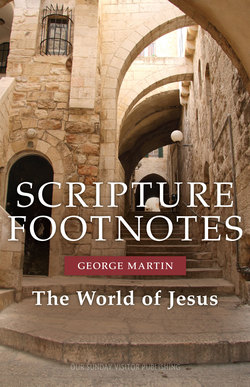Читать книгу Scripture Footnotes - George Martin - Страница 11
На сайте Литреса книга снята с продажи.
Оглавление2
The Lay of the Land
Regions and Places
What was the Decapolis?
The Greek word decapolis means “ten cities,” and it originally referred to a confederation of ten cities chiefly situated east of the Jordan River. At the time of Jesus the Decapolis was an administrative district attached to the Roman province of Syria. The cities of the Decapolis had a predominantly or entirely Gentile population, were Greek in their culture and religion, and were wealthy compared with the Jewish villages of Galilee. Archaeologists have uncovered colonnaded, paved streets, as well as theaters, temples, sports facilities, and other evidence of Greek lifestyle in cities of the Decapolis.
What kind of desert is there in Palestine?
The “desert of Judea” (Matt 3:1) is a rocky wilderness, not a desert of fine blowing sand. It is a barren region because it receives little rain. The Judean desert stretches from the Mount of Olives and the eastern outskirts of Jerusalem down to the Jordan River and Dead Sea, far below sea level. Although in its lower elevations it is devoid of plant life, sufficient scrubby vegetation grows in its upper elevations to pasture the goats and sheep of nomadic shepherds.
What was Galilee like, the native area of “Jesus the Galilean” (Matt 26:69)?
Galilee was the northern region of ancient Palestine. Most of the Galilean sites mentioned in the Gospels were in what was considered lower Galilee in the time of Jesus: a roughly circular area twenty to twenty-five miles across, with the Sea of Galilee on the east and the coastal hills of the Mediterranean on the west. Nazareth was near the southern edge of lower Galilee, and Capernaum was in the northeast. The general character of Galilee was rural. The two most significant cities in lower Galilee — Sepphoris and Tiberias — seem to have had little cultural impact on those who did not live within them. Most of the inhabitants of Galilee supported themselves by farming or fishing and lived in villages or small towns. Galilee contained the estates of its ruler, Herod Antipas, and his wealthy supporters, and some Galileans worked as tenant farmers or day laborers on these estates. There was not much of a middle class in Galilee; there was a small, wealthy elite and many ordinary and rather poor people. The Galilee to which Jesus addressed himself was primarily the Galilee of ordinary people: while his message reached members of the upper class, the Gospels never describe him going into Sepphoris or Tiberias, even though Sepphoris lay only four miles from Nazareth, and Tiberias seven miles from Capernaum. Galilee during the ministry of Jesus has sometimes been described as a paganized area, a region of lax religious observance, and a hotbed of revolutionary nationalism, but none of these characterizations is accurate. In general, Galilee was Jewish rather than pagan, and the Jews of rural Galilee were traditional in their religious practices, relatively uninfluenced by Greek culture, and slow to heed calls to revolt.
What was Gennesaret, where Jesus healed many people?
Gennesaret (1 Macc 11:67; Matt 14:34; Mark 6:53) is a plain on the northwest shore of the Sea of Galilee, lying between Capernaum and Magdala. According to Josephus, a first-century Jewish historian, Gennesaret extends three and one half miles along the shore of the Sea of Galilee and two and one half miles inland. Josephus describes it as “wonderful in its characteristics and its beauty” and praises its fertility: “thanks to its rich soil, there is not a plant that does not flourish there, and the inhabitants grow everything. The air is so temperate that it suits the most diverse species … it is watered by a spring with great fertilizing power, known locally as Capernaum” (Jewish War, III, 10:8).
What is the significance of the location of Gethsemane?
